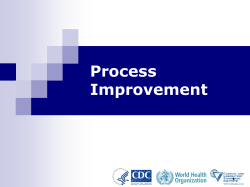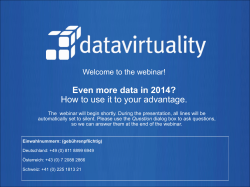
Document 235471
Introduction to Business Intelligence The journey through the BI architecture from Raw Data to Fancy Reports and Dynamic Dashboards Erasmus School of Economics Econometric Institute abstract • This seminar will introduce the BI architecture, from the very beginning showing systems components up to finally presenting business results and indicators using reports techniques. It is the journey of the raw data from source systems being transformed into relevant business information presented in a modern way on reports and dynamic dashboards. All BI-systems components will be briefly discussed, special attention is given to relevant aspects such modeling choices and user security. After the raw data is transformed and loaded into the data warehouse, a very important factor in BI success is the analyst’s choice of reporting and measures, such as (key) result indicators, performance indicators and key performance indicators. Therefore indicators and reporting will receive a special attention during the seminar. Finally it will be presented a series of types of reports and best uses for graph types and dynamic dashboards. • Key words: architecture, data warehouse, modeling, business indicators, reports, graphs, dynamic dashboards Introduction to Business Intelligence The journey through the BI architecture from Raw Data to Fancy Reports and Dynamic Dashboards Dr. Beatriz Waltrick beatrizwaltrick@hotmail.com 3 march 2010 | 1 Who uses BI? What is Business Intelligence? Internal Analytics: •Financial •Manufacturing •Research & Development •Human Resources BI Data Warehouse • • • “ A data warehouse is a subject oriented, integrated , time variant, nonvolatile collection of data in support of management’s decision-making process” Bll Inmon • “A data warehouse is a copy of transactional data specifically structured for query and analysis” Ralph Kimball • • • BI is the process of transforming data into usable information and knowledge 3 External Analytics: Customer •Supplier Analytical Competitors use BI, they have lots of data, they organize it and put it in DWH. They integrate the data in areas of their business where it really matters. In domain where decisions must be made quickly or very often, BI will embed analysis into decisions systems. They make lots of money! They will lead us into the future! Source: Davenport & Harris, 2007. Competing on Analytics: the new science of winning. Harvard. USA. 215p. 4 sustainable business development Introduction to Business Intelligence General Architecture A general framework for sustainability evaluation and choice of business indicators STEP 1 KPI’s and Reporting DESCRIPTION 2 Description of a business (example: production system) Identification of EES issues 3 Choice of indicators 4 Measure sustainability indicators 5 Evaluation and monitoring (Economic, Ecologic, Social) Transferring data from: •Source Systems to DWH (through ETL) – Back end •DWH to Reporting applications (through MD) – Front end 5 Source: Waltrick, B. 2003. Contribution of Holstein Cows to Sustainability of Dairy 6 System in Brazil. PhD Thesis, Wageningen Universiteit, Nederland. p 184 1 Balanced Scorecard Types of performance measures: • • Key result indicator (KRIs) tell you how you have done in a perspective or critical success factor FINANCIAL It is like onions… CUSTOMER FOCUS Increase customer satisfaction, targeting, customers who generate most profit INTERNAL PROCESS Delivery in full on time, optmizing technology, effective erlationships with key stakeholders EMPLOYEE SATISFACTION LEARNING AND GROWTH Positive company culture, retention of key staff, increased recognition (P) Empowerment, increasing expertise, and adaptability Result indicator (RIs) tell you what you have done • Performance indicators (PIs) tell you what to do • KPIs tell you what to do to increase performance dramatically Source: Parmenter, D. 2010. Key Performance Indicators: developing, implementing, and using 7 winning KPIs. Wiley & Sons, Inc., Hoboken, New Jersey, 2nd ed., p 300. ENVIRONMENT/ COMMUNITY Utilization of assets optimization of working capital Supporting local business, linking with future employees, community leadership (P) Sources: KAPLAN & NORTON, 1996. The balanced Scorecard :Translating Strategy into Action. Boston : Harvard Business School press. PARMENTER, D. 2010. Key Performance Indicators: developing, implementing, and using winning KPIs. Wiley & Sons, Inc., Hoboken, New Jersey, 2nd ed., p 300. 8 Scorecards and Dashboards Multiple Dashboards in a Single Document Scorecards and Dashboards This dashboard evaluates category performance by region. It includes revenue and profitability details by subcategory and supplier. 9 Enteprise Reporting Classic production and operational report that lists the sales cost and profit margins for various categories across different regions. 10 Slice and Dice Analysis This report displays revenue and profit information by month for a particular category and subcategory. The category of interest is selected at the top 11 12 2 Alerts and Proactive Notification Reports can be designed to alert managers to business exceptions Advanced and Predictive Analysis This dashboard analyzes certain demographic factors about each customer who are likely to churn (factors that determine the steady-state level of customers a business will support). Inventory by Subcategory Alert appears when certain business conditions are not met. South North Mid 13 Advanced Visualizations • • Interactive Bubble Plot 14 Advanced Visualizations: Single-Value Visualizations • Gauge Interactive • Thermometer Stacked Area • Cylinder • Time Series Slider Chart 15 Best Uses for Graph Types • 16 Best Uses for Graph Types • Time series comparisons: Frequency distribution : OR • Targets and quota : Curved Lines 17 18 3 Best Uses for Graph Types Best Uses for Graph Types Component comparisons for Components • • of More than One Total: Item comparisons: Bevel Effects vs. 20 19 Best Uses for Graph Types • Correlation comparisons: Gradients : 21 4
© Copyright 2025





















